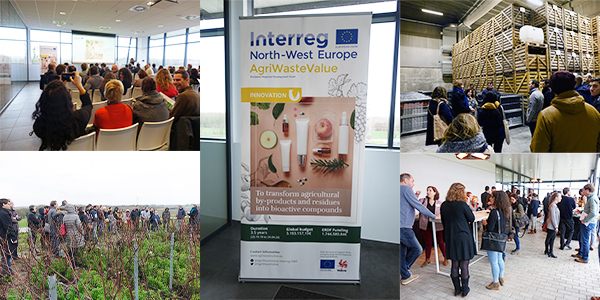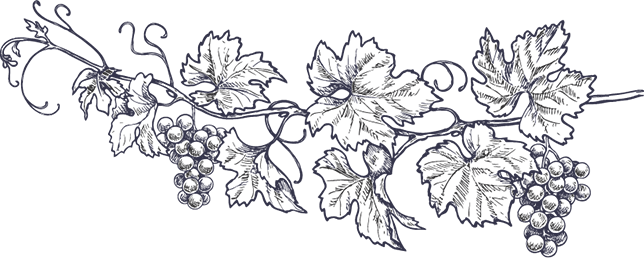
Feedback AgriWasteValue kick-off event
11.12.2019The AgriWasteValue kick-off event was held on Wednesday, December 11, 2019 in a Belgian vineyard, “Le Domaine du Chant d’Eole”, in presence of 60 people, most of them specialists of the different fields (cosmetics, nutraceutics, chemistry, energy and agriculture) concerned by the project.
On-trend and relevant research
The day started by a presentation of the project, by Clémence Rotolo and Cédric Peyrot, from AgroParisTech Innovation (France). The AgriWasteValue project is part of the Interreg North-West Europe programme, which is a European research programme fostering transnational cooperation to make Northwestern Europe a key economic player and an attractive place to work and live, with high levels of innovation, sustainability and cohesion. This project has for starting point the growing demand for consumers to return to more natural products, especially in cosmetics and nutraceuticals . These natural products are currently exported in Europe while a lot of biomass is actually available here, in North-West Europe! This is why 9 partners (AgroParisTech Innovation, Celabor, Cosmetic Valley, Delphy, EPFL, Eurasanté, PFI, University of Reims Champagne-Ardenne and ValBiom) from 5 countries (France, Belgium, Netherlands, Germany and Switzerland) are going to work together for 3.5 years (October 2018 – April 2022).
The AgriWasteValue project aims to transform agricultural by-products and residues from the European North-West regions into bioactive compounds in order to use them in key industrial sectors such as the cosmetic and nutraceutical fields, and then, in a second phase, in the energy, chemical and agricultural sectors.
How does it work exactly?
Steps:
- Production of bioactives via extraction
- Biochemical treatment (also called fermentation) transforming lignocellulosic fractions into biosolvents and biobased chemicals
- Production of biogas and fertilizer with the final residues

The final goal is to get to a new circular economy by using the woody part of the by-products and transforming it into new bioactive molecules. 3 different biomasses will be used for this research: vines (3 000 000 hectares in Europe), apple trees (470 000 ha) and pear trees (100 000 ha).
To support companies in their environmental shift
Justine Hegon of Cosmetic Valley (France), a cluster of almost 600 members of all the chain – from raw materials to end products, exposed the structure and expectations of the cosmetics sector in France. The French cosmetic market in 2018 was evaluated at 11.429€ billion, or 15% of the European market. Cosmetic Valley has an environmental responsibility when accompanying the companies they advise: food waste and up cycling, waterless, plastic free, clean label … They have a sustainability strategy that fits within the AgriWasteValue project: Cosmetic Valley’s role as a partner of the project is to inform and raise awareness in the cosmetic industry.
AgriWasteValue also relates to the nutraceutical sector. Eurasanté is the partner of the project that is also informing and accompanying companies from the food complement field to shift to more natural and local ingredients, to meet the consumer’s growing expectations.
Promising local and natural ingredients
Pierre Darme, PhD student of the University of Reims Champagne-Ardenne, revealed that new anti-parasitic compounds had been discovered in temperate bark trees. These anti-parasitic compounds are especially interesting against the toxoplasmosis, a parasitic disease mainly known to be carried by the cat and dangerous for pregnant women. These compounds are found in the barks of Northern Europe that are an abundant product that is still undervalued and not identified in chemistry. The University of Reims Champagne-Ardenne tested 3 extracts (n-heptane, MeOH, MeOH/H20) from 10 different species, and the best candidate so far is the black alder (best resistance to the parasite growth). The barks’ activity and usefulness have been proved here on toxoplasmosis and on multiple bacteria and yeasts.
Sébastien Cajot, of Celabor (Belgium), presented the first research results of the AgiWasteValue project. The biomass used for this research comes from 17 varieties (5 vine, 9 apple tree, 3 pear tree), of residues left on the ground after tree trimming. One of the first interesting results of the eco-extraction process is that Celabor found out that we can have higher activity and better extraction of antioxidant molecules with ethanol 70%. The main active components found in each raw material were:
- Pears:
- Presence of epicatechin and catechin molecules (used to reduce oxidative stress)
- Presence of chlorogenic acid (used in the food industry to fight against obesity)
- Vines:
- Presence of epicatechin and catechin molecules
- Presence of resveratrol (powerful antioxidant used in anti-aging care, both in cosmetics and nutraceutical products)
- Apples:
- Presence of phloridzin (used as a colourant in the cosmetics and nutraceutical fields)
These first results are very promising but Celabor pointed out that the project has to study the variability samples between different years, lots, etc. Next steps include green extraction and formulation with industrials.
Where to get this raw material locally?
AgriWasteValue aims to develop local value chains and this is why the project is developing a digital map tool on its website. This map will allow the companies to see where they can get the raw material that is the nearest from them, and will also allow the producers to say how much and where they have by-products available.
Evolution to more ethical and Eco responsible markets - BASF Beauty Care Creations
Valérie Andre-Frei, working for BASF Beauty Care Solutions (France), presented “From plants to cosmetic active ingredients: Goals & Challenges of Eco-friendly & Sustainable Development”. Beauty Creations is the Cosmetic Active Ingredients business of BASF, focusing on Skin Care & Hair Care markets. BASF has an expertise in vegetal extraction for more than 30 years, with green technologies and know-how that allow to extract and concentrate the active polychemicals from plants. One of their programs is to valorise the unused parts of the Rambutan trees (medium size tropical tree), which provide a set of new solutions with multiple benefits for skin and hair care. For example, the leaves are used for anti-aging creations, the pericarps (peels) have moisturizing properties and the seed offers hair protection.
The AgriWasteValue project responds to the ongoing need linked to the intensification of their Eco-Conception approach (up-cycling, by-products…) in line with the overall objectives of BASF “We create chemistry for a sustainable future”.
Visit of the vineyard and demonstration of pruning
The launch event of AgriWasteValue ended with a very interesting visit that allowed participants to realise how much residues and by-products are being left out after the cutting of vines. The “maître de chai” of Le Chant d’Eole demonstrated a pruning of the vines and explained that they estimated that each vine stock could approximatively give 10 kg of residues for one cut. In the best season for the vine, it can grow 10 centimetres a day! Cutting it is therefore mandatory if the producers want the plant to concentrate its energy into growing grapes. Today, the vineyard has more or less 135 000 vines. If you do the math, a lot of by-products and residues are produced from the vine each year and are left on the ground! After these interesting explanations, the participants had the chance to discover the production area, the tanks and the storage room.

